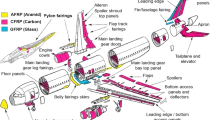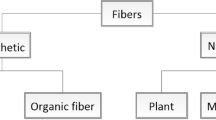Abstract
SiCf/SiC composites are difficult-to-machine materials with high hardness, high brittleness, and anisotropy. Exploring the material removal mechanism in depth is the key basic research to achieve high-quality machining of ceramic matrix composites. The results of orthogonal cutting experiments indicated that the brittle regime of ceramic matrix composites during cutting could be further subdivided into micro brittle fracture regime and macro brittle fracture regime, based on the different basic material units where fiber brittle fracture occurs. A critical cutting depth model for micro–macro brittle fracture transition of ceramic matrix composites was established based on orthogonal cutting theory and composite micromechanics. Comparison of experimental results and model calculation results indicated that the critical cutting depth model for micro–macro brittle fracture transition had high reliability. The critical cutting depth of micro–macro brittle fracture transition in the cutting of SiCf/SiC composites was less than 12 μm.

















Similar content being viewed by others

References
Zhang Y, Hu J, Zhou L, Zhang X, Yang J, Liao C, Kan Y, Dong S, Li Y (2022) Influence of fiber surface properties of SiCf/SiC composites on the interfacial debonding behavior. J Eur Ceram Soc 44(2):795–801. https://doi.org/10.1016/j.jeurceramsoc.2023.09.081
Yin XW, Cheng LF, Zhang LT, Travitzky N, Greil P (2017) Fibre-reinforced multifunctional SiC matrix composite materials. Int Mater Rev 62(3):117–172. https://doi.org/10.1080/09506608.2016.1213939
Binner J, Porter M, Baker B, Zou J, Venkatachalam V, Diaz VR, D’Angio A, Ramanujam P, Zhang T, Murthy TSRC (2020) Selection, processing, properties and applications of ultra-high temperature ceramic matrix composites, UHTCMCs - a review. Int Materials Rev 65(7):389–444. https://doi.org/10.1080/09506608.2019.1652006
Chen Y, Chen Y, Wang D, Ai S (2022) Generating 3D digital material twins for woven ceramic-matrix composites from μCT images. J Am Ceram Soc 105(1):481–497. https://doi.org/10.1111/jace.18044
Huo S, Yan Q, Gao X, You Y (2017) Ceramic matrix composite turbine vane thermal simulation test and evaluation. J Int J Turbo Jet-Engines 37(3):0048. https://doi.org/10.1515/tjj-2017-0048
Song C, Ye F, Cheng L, Liu Y, Zhang Q (2022) Long-term ceramic matrix composite for aeroengine. J Adv Ceram 11:1343–1374. https://doi.org/10.1007/s40145-022-0611-5
Panakarajupally RP, Mirza F, El Rassi J, Morscher GN, Abdi F, Choi S (2021) Solid particle erosion behavior of melt-infiltrated SiC/SiC ceramic matrix composites (CMCs) in a simulated turbine engine environment. Compos B Eng 216:108860. https://doi.org/10.1016/j.compositesb.2021.108860
Katoh Y, Snead LL (2019) Silicon carbide and its composites for nuclear applications-historical overview. J Nucl Mater 526:151849. https://doi.org/10.1016/j.jnucmat.2019.151849
Takaaki K, Yutai K, Takashi N (2020) Design and strategy for next-generation silicon carbide composites for nuclear energy. J Nucl Mater 540:152375. https://doi.org/10.1016/j.jnucmat.2020.152375
Braun J, Sauder C (2022) Mechanical behavior of SiC/SiC composites reinforced with new Tyranno SA4 fibers: effect of interphase thickness and comparison with Tyranno SA3 and Hi-Nicalon S reinforced composites. J Nucl Mater 558:153367. https://doi.org/10.1016/j.jnucmat.2021.153367
Porter MT, Binner J, Cinibulk MK, Stern KE, Yakovlev VV (2023) Computational characterisation of microwave heating of fibre preforms for CVI of SiCf/SiC composites. J Eur Ceram Soc 43(5):1808–1827. https://doi.org/10.1016/j.jeurceramsoc.2022.12.035
Liu R, Wang F, Zhang J, Chen J, Wan F, Wang Y (2021) Effects of CVI SiC amount and deposition rates on properties of SiCf/SiC composites fabricated by hybrid chemical vapor infiltration (CVI) and precursor infiltration and pyrolysis (PIP) routes. Ceram Int 47(19):26971–26977. https://doi.org/10.1016/j.ceramint.2021.06.110
Song C, Liu Y, Ye F, Cheng L, Zhang P, Chai N (2021) Enhanced mechanical property and tunable dielectric property of SiCf/SiC-SiBCN composites by CVI combined with PIP. J Adv Ceram 10:758–767. https://doi.org/10.1007/s40145-021-0470-5
Lv H, Ge M, Zhang H, Zhang H, Yu S, Chen M, Zhang W (2023) Microstructure, thermophysical properties and oxidation resistance of SiCf/SiC-YSi2-Si composite fabricated through reactive melt infiltration. J Eur Ceram Soc 43(14):5950–5960. https://doi.org/10.1016/j.jeurceramsoc.2023.06.070
Diaz OG, Luna GG, Liao Z, Axinte D (2019) The new challenges of machining ceramic matrix composites (CMCs): review of surface integrity. Int J Mach Tools Manuf 139:24–36. https://doi.org/10.1016/j.ijmachtools.2019.01.003
An Q, Chen J, Ming W, Chen M (2021) Machining of SiC ceramic matrix composites: a review. Chinese J Aeronaut 34(4):540–567. https://doi.org/10.1016/j.cja.2020.08.001
Qu S, Yao P, Gong Y, Chu D, Yang Y, Li C, Wang Z, Zhang X, Hou Y (2022) Environmentally friendly grinding of C/SiCs using carbon nanofluid minimum quantity lubrication technology. J Clean Prod 366:132898. https://doi.org/10.1016/j.jclepro.2022.132898
Qu S, Yao P, Gong Y, Yang Y, Chu D, Zhu Q (2022) Modelling and grinding characteristics of unidirectional C-SiCs. Ceram Int 48(6):8314–8324. https://doi.org/10.1016/j.ceramint.2021.12.036
Luna GG, Axinte D, Novovic D (2022) Engineered grinding tools reimplemented by precise sharpening: a case study on an ultrahard ceramic matrix composite (CMC). CIRP Ann 71(1):289–292. https://doi.org/10.1016/j.cirp.2022.04.011
He J, Qian N, Su H, Fu Y, Ding W, Xu J (2023) Wear behavior and machining quality of novel high-sharp brazed diamond abrasive core drills during drilling SiCf/SiC composite micro-holes. Int J Adv Manuf Technol 128:3801–3816. https://doi.org/10.1007/s00170-023-12146-x
Bie W, Chen F, Wang X, Chen S, Fu Z, Zhao B (2023) Longitudinal-torsional coupled rotary ultrasonic machining end surface grinding of SiCf/SiC composites: a mechanical model of cutting force. Int J Adv Manuf Technol 129:1227–1248. https://doi.org/10.1007/s00170-023-12360-7
Dong Z, Zhang H, Bao Y, Yang F, Wang Z, Kang R (2023) Material removal behavior of ultrasonic vibration helical grinding of SiCf/SiC composites. J Manuf Sci Eng 145(5):051008. https://doi.org/10.1115/1.4056595
Zhang B, Du Y, Liu H, Xin L, Yang Y, Li L (2021) Experimental study on high-speed milling of SiCf/SiC composites with PCD and CVD diamond tools. Materials 14(13):3470. https://doi.org/10.3390/ma14133470
Diaz OG, Axinte DA, Butler-Smith P, Novovic D (2019) On understanding the microstructure of SiC/SiC ceramic matrix composites (CMCs) after a material removal process. Mater Sci Eng A 743:1–11. https://doi.org/10.1016/j.msea.2018.11.037
Chen J, An Q, Ming W, Chen M (2019) Hole exit quality and machined surface integrity of 2D Cf/SiC composites drilled by PCD tools. J Eur Ceram Soc 39(14):4000–4010. https://doi.org/10.1016/j.jeurceramsoc.2019.05.057
Zou F, Chen J, An Q, Cai X, Chen M (2020) Influences of clearance angle and point angle on drilling performance of 2D Cf/SiC composites using polycrystalline diamond tools. Ceram Int 46(4):4371–4380. https://doi.org/10.1016/j.ceramint.2019.10.161
Chen J, Ming W, An Q, Chen M (2020) Mechanism and feasibility of ultrasonic-assisted milling to improve the machined surface quality of 2D Cf/SiC composites. Ceram Int 46(10):15122–15136. https://doi.org/10.1016/j.ceramint.2020.03.047
Chen J, An Q, Gong Q, Zeng D, Chen M (2023) Machinability improvement in milling of SiCf/SiC composites based on laser controllable ablation pretreatment. J Eur Ceram Soc 43(4):1352–1365. https://doi.org/10.1016/j.jeurceramsoc.2022.11.070
Wang C, Chen J, Zhang X, Wang T, Yang L, An Q, Ming W, Chen M (2023) Effects of ultrasonic vibration assisted milling with laser ablation pretreatment on fatigue performance and machining efficiency of SiCf/SiC composites. J Eur Ceram Soc 43(4):5925–5939. https://doi.org/10.1016/j.jeurceramsoc.2023.06.033
Li C, Piao Y, Zhang F, Zhang Y, Hu Y, Wang Y (2023) Understand anisotropy dependence of damage evolution and material removal during nanoscratch of MgF2 single crystals. Int J Extreme Manuf 5:015101. https://doi.org/10.1088/2631-7990/ac9eed
Li C, Hu Y, Wei Z, Wu C, Peng Y, Zhang F, Geng Y (2024) Damage evolution and removal behaviors of GaN crystals involved in double-grits grinding. Int J Extreme Manuf 6:025103. https://doi.org/10.1088/2631-7990/ad207f
Qu S, Wei C, Yang Y, Yao P, Chu D, Gong Y, Zhao D, Zhang X (2024) Grinding mechanism and surface quality evaluation strategy of single crystal 4H-SiC. Tribol Int 194:109515. https://doi.org/10.1016/j.triboint.2024.109515
Chen J, An Q, Chen M (2020) Transformation of fracture mechanism and damage behavior of ceramic-matrix composites during nano-scratching. Compos A Appl Sci Manuf 130:105756. https://doi.org/10.1016/j.compositesa.2019.105756
Guerra-Silva R, Teicher U, Ihlenfeldt S, González-Zamora A (2021) Finite element analysis of orthogonal cutting of cellular metals: influence of cutting conditions on chip formation and surface damage. Int J Adv Manuf Technol 113(5):1267–1280. https://doi.org/10.1007/s00170-021-06689-0
Harzallah M, Pottier T, Gilblas R, Landon Y, Mousseigne M, Senatore J (2020) Thermomechanical coupling investigation in Ti-6Al-4V orthogonal cutting: experimental and numerical confrontation. Int J Mech Sci 169:105322. https://doi.org/10.1016/j.ijmecsci.2019.105322
Li HN, Wang JP, Wu CQ, Zhao Y, Xu J, Liu X, Zhu W (2020) Damage behaviors of unidirectional CFRP in orthogonal cutting: a comparison between single-and multiple-pass strategies. Compos B Eng 185:107774. https://doi.org/10.1016/j.compositesb.2020.107774
Song C, Jin X (2020) Shearing-buckling mechanism in orthogonal cutting of unidirectional carbon fiber reinforced polymer. J Mater Process Technol 280:116612. https://doi.org/10.1016/j.jmatprotec.2020.116612
Shen G, Hu G, Liu B (2013) Mechanics of composite materials (second edition). Tsinghua University publishing house co., ltd, Beijing
Xu W, Zhang L (2016) Mechanics of fibre deformation and fracture in vibration-assisted cutting of unidirectional fibre-reinforced polymer composites. Int J Mach Tools Manuf 103:40–52. https://doi.org/10.1016/j.ijmachtools.2016.01.002
Seeholzer L, Scheuner D, Wegener K (2020) Analytical force model for drilling out unidirectional carbon fibre reinforced polymers (CFRP). J Mater Process Technol 278:116489. https://doi.org/10.1016/j.jmatprotec.2019.116489
Johnson KL (1985) Contact mechanics. Cambridge University Press, Cambridge Cambridgeshire
Hetényi M (1946) Beams on elastic foundation: theory with applications in the fields of civil and mechanical engineering. University of Michigan Press, M. Hetényi
Author information
Authors and Affiliations
Contributions
Jie Chen: conceptualization, methodology, investigation, data curation, formal analysis, visualization, writing—original draft, and writing—review and editing. Qinghong Gong: resources. Ge Song: methodology. Wenchang Zhou: supervision. Tingyu Zhang: data curation. Qinglong An: conceptualization and funding acquisition. Ming Chen: project administration.
Corresponding author
Ethics declarations
Competing interests
The authors declare no competing interests.
Additional information
Publisher's Note
Springer Nature remains neutral with regard to jurisdictional claims in published maps and institutional affiliations.
Rights and permissions
Springer Nature or its licensor (e.g. a society or other partner) holds exclusive rights to this article under a publishing agreement with the author(s) or other rightsholder(s); author self-archiving of the accepted manuscript version of this article is solely governed by the terms of such publishing agreement and applicable law.
About this article
Cite this article
Chen, J., Gong, Q., Song, G. et al. Transition of material removal mechanism in cutting of unidirectional SiCf/SiC composites. Int J Adv Manuf Technol (2024). https://doi.org/10.1007/s00170-024-13761-y
Received:
Accepted:
Published:
DOI: https://doi.org/10.1007/s00170-024-13761-y



